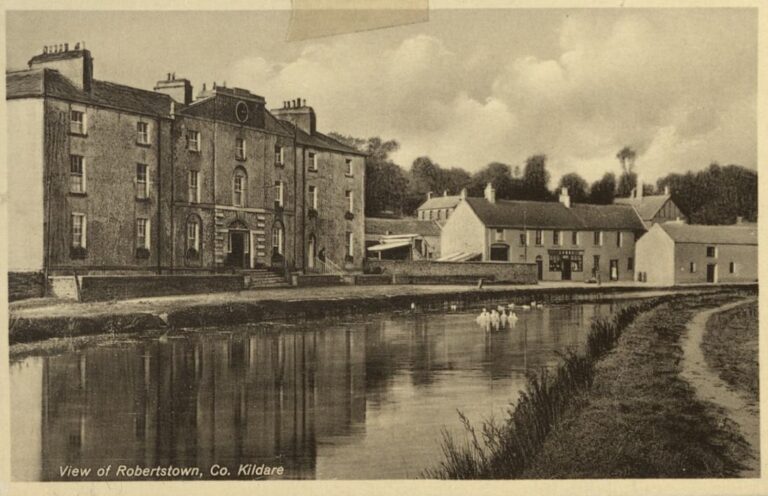Grand Canal 1751 to 1963 (From the files of Con Costello Archive)

1751 Commissioners of Inland Navigation established.
1756 Commencement of Dublin-Athy Canal construction – estimated at £98,000.
1791 Completed at a cost of £427,074.
1765 Dublin Corporation requiring water obtained a grant from Parliament of £7,000 to expediate work on the canal.
1766 Water turned on from Morrell river for this purpose – banks collapsed – water had to be turned off.
1772 Company of Undertakers of Grand Canal established – to whom all the property was transferred.
1779 First 12 miles opened to navigation – and trading commenced to Hazelhatch.
1780 Completed to Sallins.
1786 Completed to Monasterevan.
1791 Completed to Athy and connection made to Barrow Navigation.
1791-1796 Dublin Circular Line and Ringsend Docks constructed after abandonment of proposal to construct a junction with the Liffey direct from James’ St. Harbour, involving seven locks over a distance of 570 yards.
1798 Completed to Tullamore.
1804 Completed to Shannon. Shannon deepened and made navigable from Portumna to Athlone by Grand Canal Co., with £30,000 of its own funds and a Government Grant.
1834 Branch canals completed.
1840 Shannon taken over by Government, £5 compensation paid to Grand Canal Co.
Total cost of Grand Canal and Ringsend Docks was over £2,000,000.
Construction involved 63 locks, 139 overbridges, several aqueducts over rivers, and numerous houses and stores. Hotels were built at portobello (now a nursing home), Sallins, Robertstown, Daingean, Tullamore and Shannon Harbour. Total mileage was about 160 miles.
More than half was constructed through bogland involving unique and difficult engineering problems – see B. Mallins Paper in Volume II of Institute C.E.I. Transactions. Serious breaches in 1916 and 1954 when banks collapsed.
Canal Company originally only carried passengers, goods being carried by private traders until the advent of railways in 1846, after which the Canal Co. obtained authority to operate a merchandise service.
Passenger boats 60-ft. in length drawn by three horses were able to travel between locks at 10 m.p.h. Over 100,000 passengers were carried in 1837. Passenger services rapidly declined as railways were constructed and virtually closed in 1852.
For some time, the passenger services were operated in conjunction with the Bianconi to convey passengers to distant destinations such as Westport.
1846 Railway completed to Carlow.
1848 Capital of Company reduced.
1850 Carriage of merchandise commenced by Grand Canal Co.
1852 carriage of passengers ceased.
1894 Grand canal Co. purchased the Barrow Navigation Co., which had constructed the navigation from Athy to St. Mullins, 43 miles in length.
1914 Engines begin to replace horses as motive power.
1936 First motor barges of new fleet to be constructed, put into service – 46 built from 1936 to 1939.
Traffic: The decline in traffic after the advent of road motor transport was very severe. Total goods carried on the canal declined from 308,850 tons in 1913 to 180,000 tons in 1938.
During the war, there was temporary increase in maximum of about 227,000 tons, which rapidly declined after the war, to about 120,000 tons of which about 90,000 tons was carried in the Company’s barges, so that no ordinary dividend could be paid in 1947; and in 1949 no dividend was paid.
Motor lorries were introduced in 1932, and their use was gradually extended with the introduction of direct motor services.
1950 Amalgamation with C.I.E. The principal economic results of which were the absorption of the road freight vehicle fleet in the general road freight services of the National transport organization, the raising of wage rates to bring more into line with wages paid to other comparable workers in the C.I.E. organization, and the carrying out of a great deal of arrears of maintenance work on banks and lock gates. Many miles of weak banks in bogs have been strengthened, and 94 lock gates renewed since 1950.
At this time, private trading on the canal was virtually at an end.
1958 Section 23 of the Transport Act 1958 permits the Board to close to navigation any canal or part of a canal which has not been used for public navigation for three years or more. The Naas, Mountmellick, Kilbeggan and Ballinasloe Branches have been closed since the passing of this Act.
Otherwise, the Board is bound to maintain the canal in Navigable condition.
1959 Paragraph 450 of the Beddy Report of 1958 recommended that in view of the fact that the Board would benefit to the extent of £108,000 per annum by withdrawing its own barges from the canal, and carrying the traffic by its own rail and road services, it should be free to do so. The Board’s service of barge was withdrawn in 1959.
In year ended 31/3/1959, the last complete year during which the Board’s barges operated, 79,000 tons of freight were carried. Revenue was £124,000; operating costs were £158,00o and maintenance of the canal and works cost £28,000, showing a trading loss of £62,000.
